The research facilities of the Heritage Science Lab Ljubljana consist of experimental laboratory facilities and reference research collections. We are continually developing both in close strategic collaboration with the European Research Infrastructure for Heritage Science – Slovenia (E-RIHS.si), of which our Lab is a founding member.
Below is a list of the main laboratory faclities, organised in meaningful headings, available to our researchers and anyone wishing to collaborate with us. We specialise particularly in environmental monitoring and assessment, as well as characterisation of heritage materials. Our excellence has been recognised through the inclusion of our Heritage Macromolecular Lab in the catalogue of services of the EU H2020 IPERION HS project, through which we offer access to our facilities for research collaboration globally.
Organisationally, some of our facilities are managed as part of the Heritage Science Unit of the Centre for Research Infrastructure, and some are managed as part of the Chair for Analytical Chemistry at the Faculty of Chemistry and Chemical Technology, University of Ljubljana.
Environmental monitoring
Temperature/RH Data Logger
The logger measures and collects temperature and relative humidity (RH) values. It is suitable for outdoor or indoor environments. The temperature sensor range is -40 to 70 °C with a resolution of 0.02 °C, the accuracy is ± 0.25 °C from -40 to 0 °C and ± 0.20 from 0 to 70 °C. The relative humidity sensor range is 0 to 100% from -40 to 70 °C with a resolution of 0.01 % and the accuracy is ± 2.5 % from 10 to 90%, below 10 % and above 90 % is ±5 %. The logger is equipped with Bluetooth, and can be easily configured, read out and the data displayed on our mobile phones or tablets. The logger can calculate minimum, maximum, average and standard deviation.
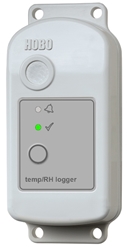
HOBO ® MX2301A Temperature/RH Data Logger
Temperature/RH Miniature Data Logger
The logger measures and collects temperature and relative humidity (RH) values. The temperature sensor range is -20 to 85 °C with an accuracy of 0.1°C ± 0.1 %. The relative humidity sensor range is 0 to 100% with an accuracy of ± 2 % from 10 to 90%, below 10 % and above 90 % is ±5 %. The logger has a USB port for connection to a computer for evaluation of the collected data.

SL54TH-A Miniature Temperature and Humidity Data Logger
TVOC sensor
The sensor measures the amount of total volatile organic compounds. The yellow sensor has a range from 1.5 ppb to 20 ppm TVOC and a lamp energy of 10.6 eV. The sensor allows remote monitoring and recording of TVOCs using a computer and software.
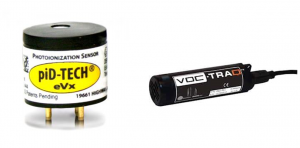
TVOC sensor VOC-TRAQ II
Temperature/Light Data Logger
The logger measures temperature and light in outdoor or indoor environments. The range of the temperature sensor is -20 to 70 °C in air with a resolution of 0.04 °C and an accuracy of ± 0.5 °C. The range of the light sensor is from 0 to 167.731 lux and the accuracy is ± 10 %. The logger is equipped with Bluetooth and can work with data for further analysis. The logger is also waterproof and can be used in various applications.
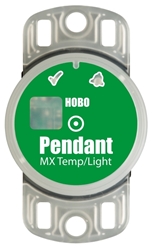
HOBO Pendant MX2202 – Temperature/Light Data Logger
Carbon Dioxide Data Logger
The logger measures carbon dioxide, temperature and relative humidity. The logger consists of non-dispersive, self-calibrating infrared CO2 sensor technology and integrated temperature and RH sensors. The temperature sensor range is 0 to 50 °C with a resolution of 0.024 °C and an accuracy of ± 0.21 °C. The range of the relative humidity sensor is 1 to 90% with a resolution of 0.01 % and an accuracy of ± 2 %. The range of the CO2 sensor is from 0 to 5 000 ppm with an accuracy of ± 50 ppm. The logger is equipped with Bluetooth and minimum, maximum, average and standard deviation can be calculated. The logger also has a USB port and can be used with a computer.
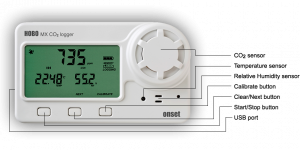
HOBO MX1102 Carbon Dioxide Data Logger
Accelerated Degradation
Accelerated degradation is testing that uses elevated conditions of heat, humidity or sunlight to speed up the natural degradation processes of materials. It is used for determination of the long-term effects of specified environmental conditions within a shorter time, usually controlled in a laboratory devices.
1. Flow-Through System With Controlled Atmosphere
With this setup, an atmosphere with the desired humidity, temperature and pollutant concentration is produced and maintained inside a reactor, where the materials to be aged are placed. In this way, the effects of various environmental parameters on material degradation can be studied.
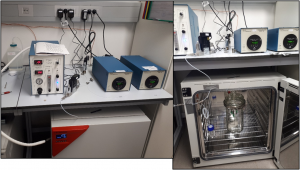
Purpose-made setup, consisting of a humidity generator V-Gen Model 1 (InstruQuest), two pollutant generators Dynacalibrator 150 (Vici) and a heating unit ED 115 (Binder). The flow of compressed air through the system is controlled by mass flow controllers GFC17A (Aalborg) and distributed with PTFE tubing and stainless steel connectors and adapters.
2. Climatic Chamber (T, RH)
The climatic chamber is used for evaluation of material properties changes during exposure to elevated temperature at different humidity levels. It is used to accelerate the effects of exposure to environmental conditions. The conditions should be carefully selected to ensure that the degradation processes remain the same as during natural degradation.
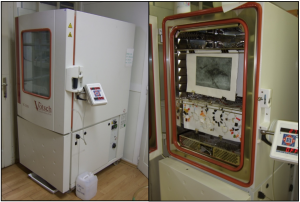
Vötsch VC 0018 climatic chamber
3. Xenon Weathering Chamber
The SUNTEST CPS+ is used to evaluate changes in the properties of materials caused by sunlight, temperature and humidity in a short period of time. Material changes that occur outdoors or indoors over months or years, such as fading, yellowing or embrittlement, can be simulated in a SUNTEST within weeks. A xenon lamp with a combination of different filters (daylight, window glass, solar, storage light) is used.
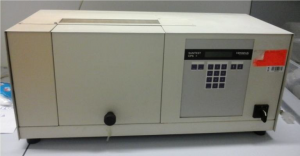
Heraeus-Suntest CPS+
Separation techniques
Gas chromatography-mass spectrometry is a powerful analytical technique for separation and identification of organic compounds. It is suitable for the determination of volatiles such as benzene, aromatics, alcohols, aldehydes, fatty acids, and others. Dynamic headspace sampling with sorbent tubes is suitable for gaseous, liquid and solid samples. The gas chromatograph equipped with a thermal desorption system enables in combination with cooled injection low limit of detection for the volatile analytes.
Available methods
-
Volatiles in the indoor atmosphere
-
Emission from different materials
-
Influence of volatiles on material degradation
Our research
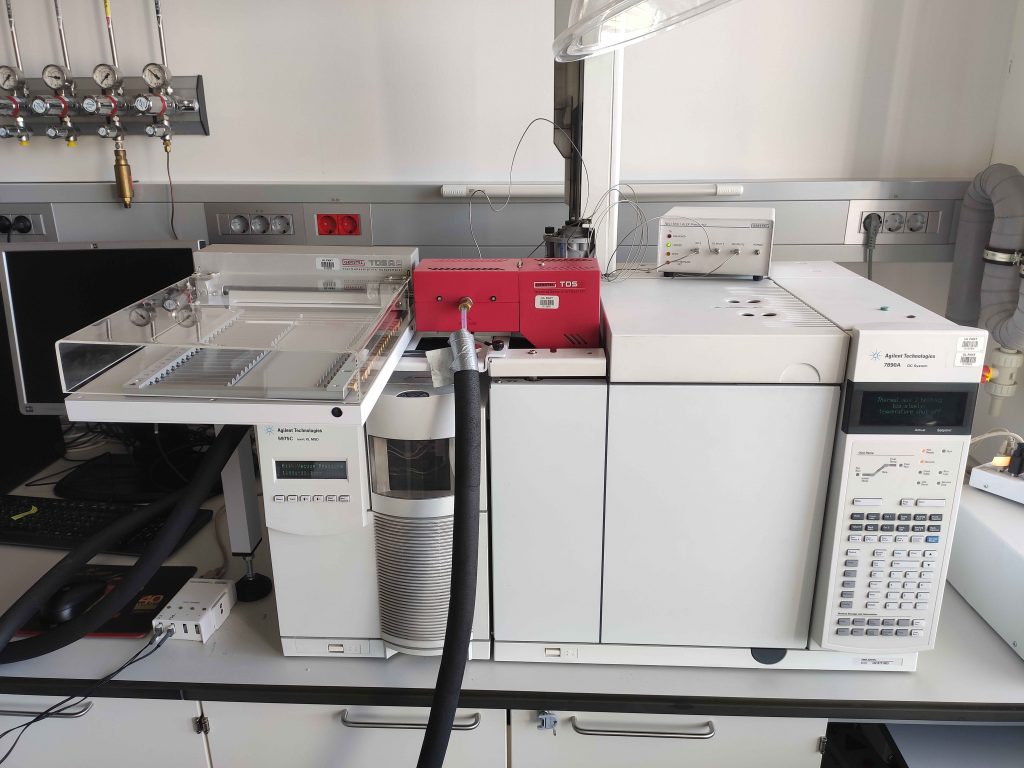
TDS-GC-MS: Gas Chromatograph 7890A coupled to Mass Spectrometer 5975C (Agilent Technologies) with Gerstel Thermal Desorption System TDS in combination with Cooled Injection System CIS, TDS-A Autosampler and Pyrolysis Module PM (Gerstel)
SEC is a type of liquid chromatography, which enables the separation of molecules according to their size. The main characteristic of stationary phases are different sized pores. Smaller molecules enter these pores and therefore they move along the column slowly in comparison to larger molecules. Some molecules are too large to enter the pores and they are excluded and consequently have no retention.
Available methods
- molecular mass distribution for natural and artificial polymers
Our research
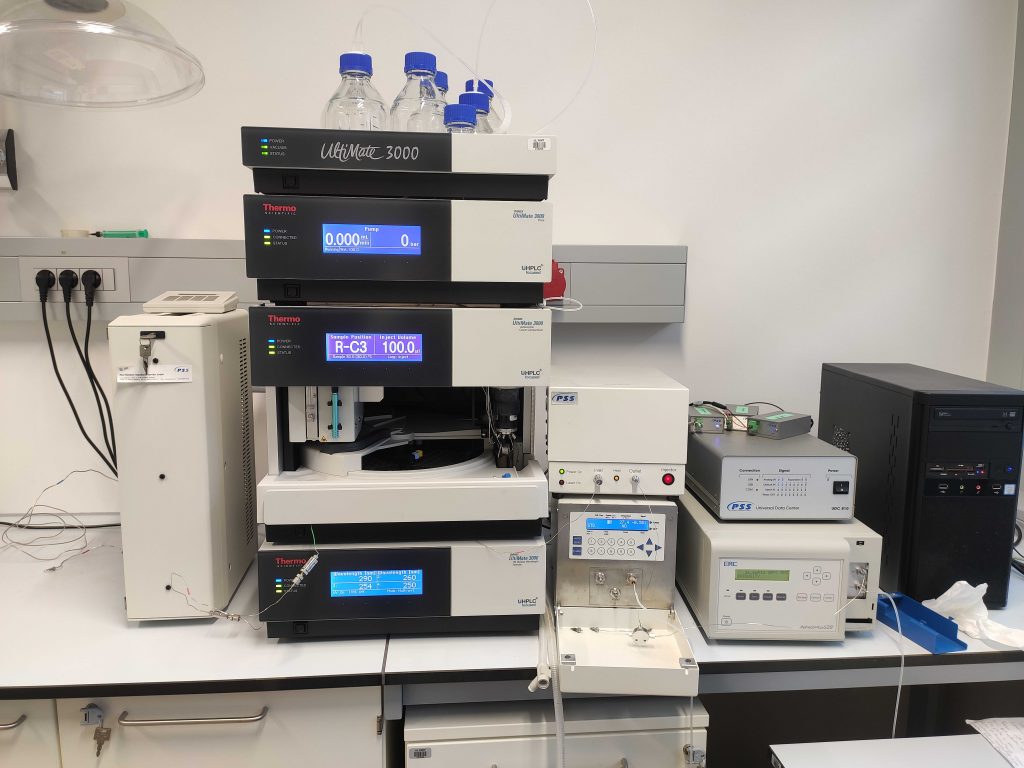
Size-Exclusion Chromatograph with refractive index detector (RefractoMax520), UV detector (RS Variable Wavelength Detector), viscometer and multi angle light scattering detectors; Termo Scientific Dionex UltiMate 3000 UHPLC

Size-Exclusion Chromatograph with UV/VIS detector, isocratic pump, column thermostat and autosampler; 1100 Series (Hewlett Packard)
Ion chromatography is a liquid chromatography technique in which ions are separated on the basis of their affinity to the ion exchange stationary phase in the column. Both positive and negative ions can be analysed with this technique, in addition to inorganic ions, organic compounds such as amino acids, nucleotides, sugars and proteins can also be analysed if in charged state. As the solvents used for elution reach extreme pH, no metal parts can come into contact with the liquid flow to prevent their corrosion.
Available methods
- Determination of acetic, formic acid, SO2 and NO2 in the indoor atmosphere.
Our research
Novel Pollutant Monitoring at National Museum of Slovenia
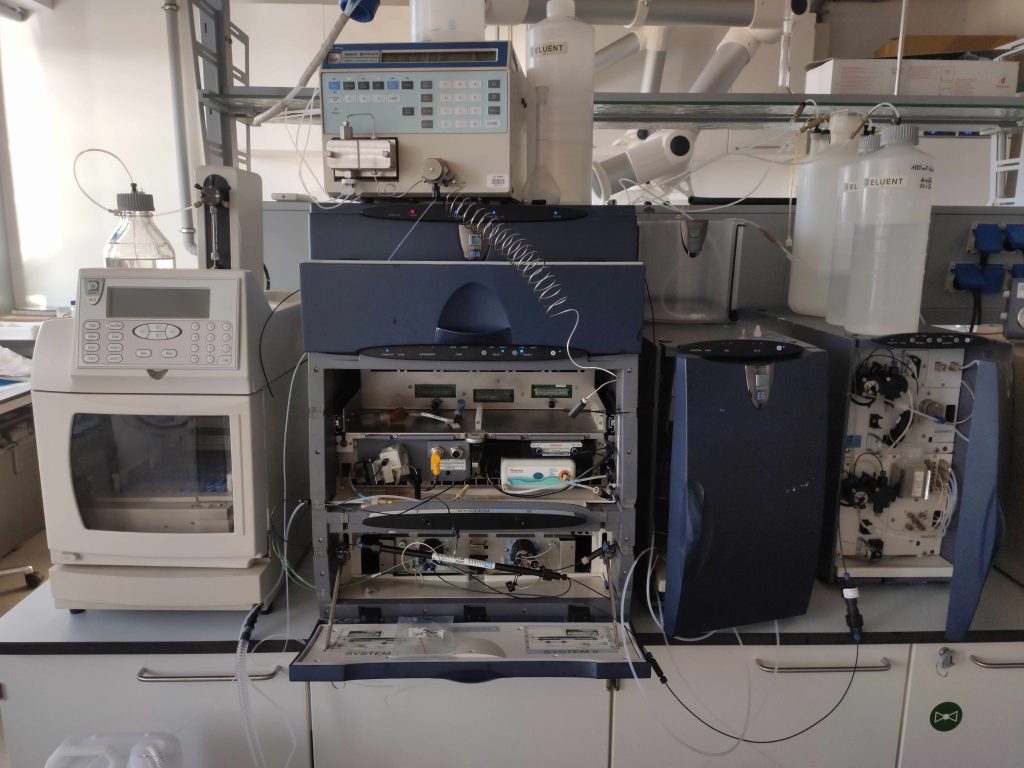
Ion Chromatograph ICS-500 (Dionex) with AS50 autosampler, eluent generator, anion suppressor, conductivity and electrochemical detectors.
HPLC is a technique, where compounds in a mixed liquid sample are separated, identified and quantified. Usually the solid phase consists of non-polar adsorbent material, which retains compounds until they are eluted with a more polar mobile phase, the duration of retention depending on their molecular properties (mostly polarity). An online detector measures variations in an optical signal, which is correlated to the quantity of the compound. A diode-array detector (DAD) is one of the possible types of detectors, where absorption at multiple wavelengths can be followed at the same time, the range usually encompassing both UV and visible light.
Available methods
- Determination of aldehydes in the indoor atmosphere

Agilent 1100 Series, including a degasser module, binary pump, autosampler, temperature-controlled column compartment and a DAD detector.
Viscometry
Viscometry is a classical method for polymer characterisation. Viscosity is connected to molecular mass of molecules diluted in the solvent. Commonly vertical capillary is used, and the time needed for a specific volume of solution to flow through the capillary is measured.
Available methods
- degree of polymerisation (DP) for natural and artificial polymers
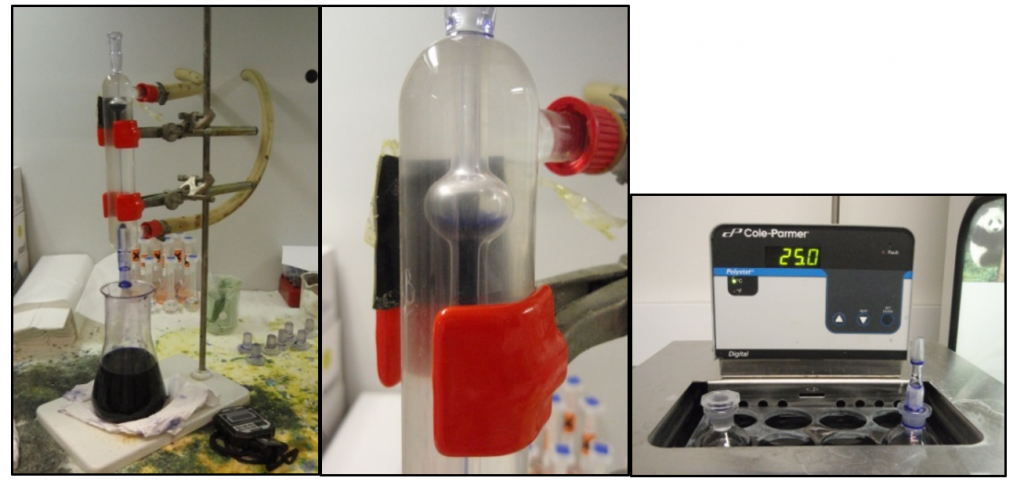
Setup for capillary viscometer
Spectroscopy
Spectrolino GretagMacbeth
The Spectrolino is a portable handheld spectrophotometer that can record reflectance spectra and work as a tristimulus colorimeter. It is used for consistent and accurate colour measurements, so it can be used to distinguish small colour changes. The working spectral range is 380 nm to 730 nm with a resolution 10 nm. The colorimetry measurements can be expressed in common colour space models, such as Lab or XYZ. It is equipped with a neutral filter, that can be exchanged for a D65 filter for approximation to daylight or a polarised filter.
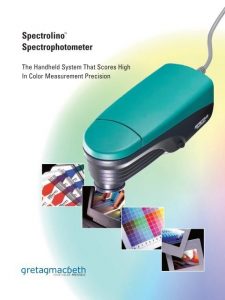
Infrared spectroscopy is a useful non-invasive analytical tool for the identification and study of solid samples. A beam of IR light (4000 – 400 cm-1) is used to excite molecular vibrations, so absorption occurs at frequencies characteristic for the sample’s structure. A transmittance or absorbance spectrum is generated. IR spectroscopy is often used to analyze covalent bonds and identify structures in samples. The region ≥ 1500 cm-1 contains characteristic bands for functional groups in terms of position and intensity and the region < 1500 cm-1 has intricate patterns, that can be used as a fingerprint for identification of a compound.
Near infrared spectroscopy or NIR spectroscopy uses near infrared light (780 – 2500 nm) to excite molecular vibrations. It is particularly useful because it requires little or no sample preparation due to its deeper penetration compared to mid infrared radiation. Near-IR spectra are typically more complex at wide bands, because the bands are a combination of different molecular vibrations and overtones. Direct assigment to chemical compounds is difficult, so multivariate calibration techniques such as principal component analysis, partial least squares and artificial neural networks are used.
Electrochemical techniques
pH is a determination of acidity or alkalinity by measuring the hydrogen ion concentration in a solution. A pH electrode is a glass electrode sensitive to hydrogen ions. The potential of the electrode linearly depends on pH, as described by the Nernst equation. Modern potentiometric pH meters are a combination of a glass and reference electrodes, that display the voltage between two electrodes as a corresponding pH value.
pH measurements of aqueous solutions or water-based extracts can provide insight into the samples’ properties or ongoing processes. According to the TAPPI T 509 standard (Hydrogen ion concentration of paper extracts – cold extraction method) sample of paper is extracted in MiliQ water.
Equipment for pH determination is the pH meter SevenCompact Mettler Toledo and combined glass electrodes:

InLab Micro pH electrode, pH 0 – 14, 0 – 80 ˚ C, Mettler Toledo
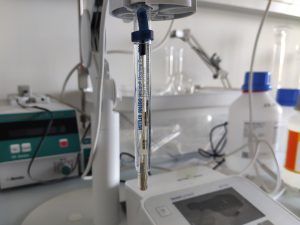
InLab Routine Pro-ISM pH electrode, pH 0 – 14, 0 – 100 ˚ C, Mettler Toledo
If samples of paper can’t be destroyed or otherwise defaced, for pH determination flat combination electrode according to the TAPPI T 529 standard (Surface pH measurement of paper) is used. Small volume of water is placed on a sample and the pH is measured with flat-surface combined pH electrode which is in contact with wet part of the sample.
Our research
Matija Strlič, Yun Liu, Dirk Andreas Lichtblau, Gerrit De Bruin, Barry Knight, Thea Winther, Irena Kralj Cigić, Richard G. Brereton. Development and mining of a database of historic European paper properties. Cellulose. 2020, str. 1-13, ilustr. ISSN 0969-0239. [COBISS.SI-ID 22766851]

